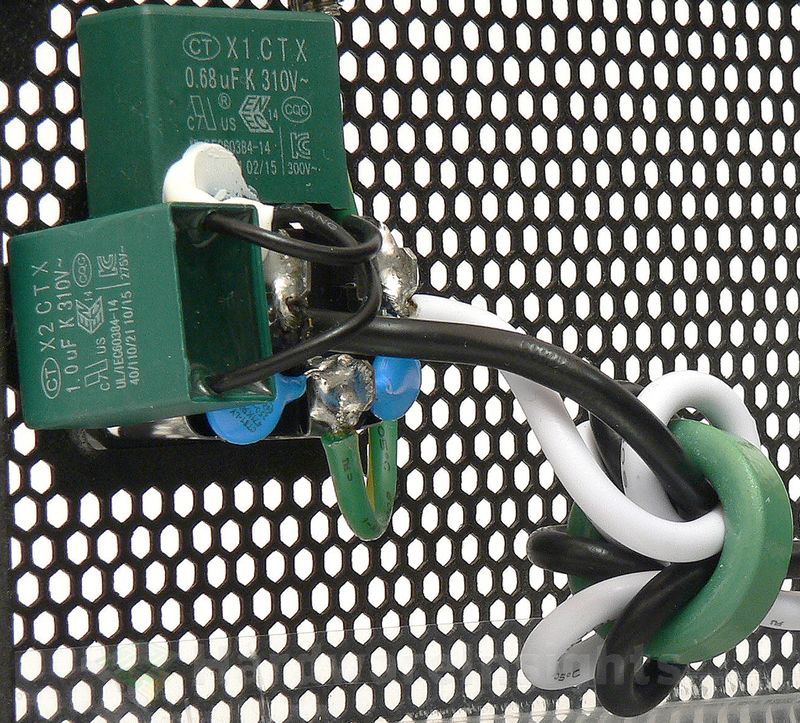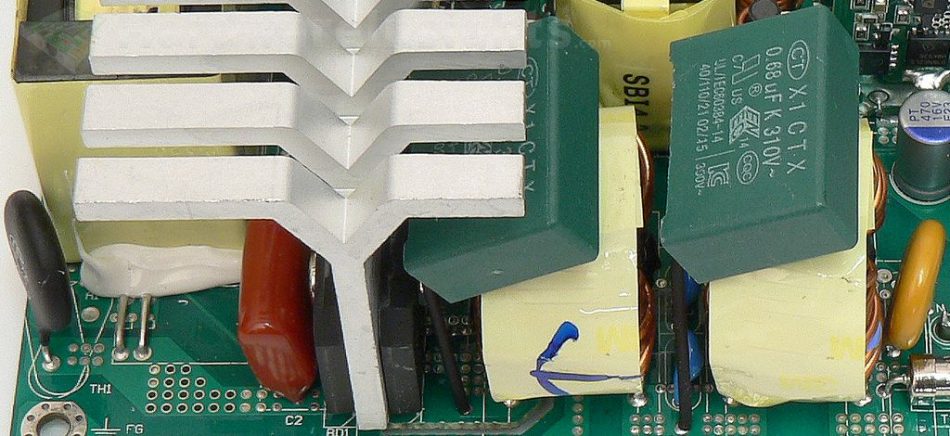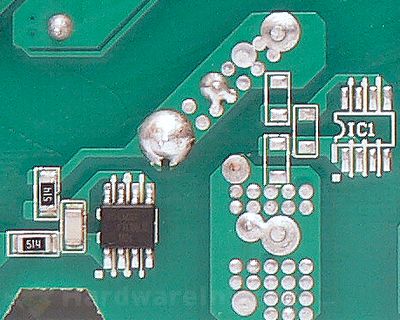Contents
- 1Introducing the Silverstone Strider Titanium 600 W (SST-ST60F-TI)
- 1.1Packaging and accessories
- 2Connectors & cabling
- 2.1Casing & cooling
- 3Input filtering
- 4Primary side
- 4.1+5 V stand-by rail
- 5Secondary side
- 5.1Build quality
- 6Load testing
- 6.1Loading +5 V SB
- 6.2Hold-up time
- 6.3Combined loading
- 6.4Combined loading ripple
- 6.5Crossloading, overloading
- 6.6Crossloading, overloading ripple
- 6.7Fan speed, temperatures and noise
- 7Conclusion and evaluation
- 7.1Thanks
- 7.2Discussion
Input filtering
The first stage of the input filtering is similar to other Enhance units, it has two X-type film capacitors (instead of the usual one) as well as two ceramic Y capacitors. There is no discharge IC here and no AC switch. The receptacle is partially shielded though. The conductors leading to the main board pass through a ferrite core.
Then there are two more Y capacitors, two X capacitors, two larger common mode chokes (using thick wire to reduce losses), a varistor and also a thermistor. They have no heatshrink tubing over them and what’s also interesting, is that there’s no relay to bypass the thermistor. I would have very much expected this to be implemented here, in order that they would have been able to save some power to reach its high efficiency rating, but perhaps Enhance found some other method here that negated the need.
The X-capacitor discharge IC is in fact present in the SST-ST60F-TI, the Champion Micro CM02X. It is located directly on the board, this is not the best way of implementing this feature. Because in the chance that the fuse blows, it is then unable to discharge the X caps after the fuse. But here it was placed on the input part of the fuse, so it does discharge the two X caps on the AC receptacle (in front of the fuse) no matter the state of the fuse. And there will not be conductive path from the caps on the board through the blown fuse, so the electric-shock protection present will be working safely.
The X capacitors (between the live and neutral) and Y capacitors (between live and ground/neutral and ground) are used to filter out high-frequency ripple that emanates from the power grid. That is the noise of which manifests in the form of feedback from electronic devices which lack adequate filtering due to cost cutting. But also from devices where filtering was very difficult to implement (powerful devices, e.g. microwave ovens). It also prevents ripple from this unit itself from feeding back into the grid.
Chokes are used for the same reason, and together with the X/Y capacitors they form an input filter. Such filters are often made as one component, they may also be integrated together with AC receptacle. These components may also (partially) help to filter smaller voltage spikes in the power grid. To suppress more serious spikes (for example from distant lightning strikes hitting the power grid), the MOV (metal-oxide varistor) is used. Thermistor is then used to suppress current spikes when first connecting the unit to power (i.e. flipping the power switch).
The Y capacitors are also often situated between the high-voltage primary and the low-voltage secondary sides. These days, more Y capacitors are used even between primary common (ground after an input rectifier) and earth ground to suppress internal interference and keep it from getting to the secondary side. It is because really high-frequency ripple goes everywhere it can to some extent (including coupling through the insulation, metal casing etc…). That is also why the AC wires themselves are often inserted through the ferrite toroid inductor (to suppress such coupling).




